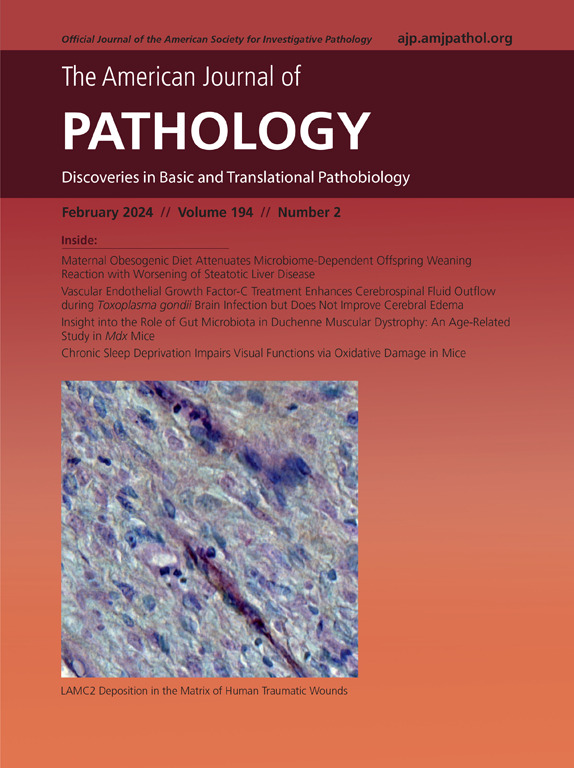EMILIN-1 Suppresses Cell Proliferation through Altered Cell Cycle Regulation in Head and Neck Squamous Cell Carcinoma
IF 4.7
2区 医学
Q1 PATHOLOGY
引用次数: 0
Abstract
Extracellular matrix (ECM) proteins play an important role in the pathological processes of tumor development and progression. Elastic microfibril interface located protein-1 (EMILIN-1), an ECM glycoprotein, is linked to cell adhesion and migration. It was identified from head and neck squamous cell carcinoma (HNSCC) tissues that down-regulated EMILIN-1. It is associated with an increased risk of secondary primary malignancy development in HNSCC and hypothesized to function as a tumor suppressor in HNSCC. This study showed that EMILIN-1 expression in HNSCC tissues was specific to the stromal area, and secreted-EMILIN-1 level was higher in fibroblasts isolated from HNSCC tissues than in HNSCC cells. EMILIN-1 overexpression decreased cell proliferation, migration, and invasion in FaDu and CAL27 cells. Knockdown of EMILIN-1 in HNSCC cancer-associated fibroblasts induced cell proliferation and migration. The conditioned medium from EMILIN-1 knockdown cancer-associated fibroblasts increased HNSCC cell proliferation, and the co-culture system enhanced cancer cell migration and invasion. RNA-sequencing analysis revealed that the cell cycle and aurora kinase signaling were the most significant enrichment pathways, confirmed at the protein level. Furthermore, in an in ovo chick chorioallantoic membrane model, overexpression of EMILIN-1 in FaDu cells reduced tumor size and Ki-67–positivity and increased cleaved caspase-3–positive cells. These findings suggest that EMILIN-1 suppresses HNSCC growth partly through the down-regulation of cell cycle and aurora kinase signaling pathways.

EMILIN-1通过改变头颈部鳞状细胞癌的细胞周期调节来抑制细胞增殖。
细胞外基质(ECM)蛋白在肿瘤发生发展的病理过程中起着重要作用。弹性微纤维界面定位蛋白-1 (EMILIN-1)是一种ECM糖蛋白,与细胞粘附和迁移有关。我们之前从头颈部鳞状细胞癌(HNSCC)组织中发现,下调EMILIN-1与HNSCC中继发性原发性恶性肿瘤发展的风险增加有关,并假设EMILIN-1在HNSCC中起肿瘤抑制作用。在这项研究中,我们发现EMILIN-1在HNSCC组织中的表达是特异性的,并且从HNSCC组织中分离的成纤维细胞中分泌的EMILIN-1水平高于HNSCC细胞。EMILIN-1过表达降低了FaDu和CAL27细胞的增殖、迁移和侵袭。在HNSCC癌相关成纤维细胞(CAFs)中敲低EMILIN-1诱导细胞增殖和迁移。emilin -1敲低的CAFs条件培养基增加了HNSCC细胞的增殖,共培养系统增强了癌细胞的迁移和侵袭。rna测序分析显示,细胞周期和极光激酶信号是最重要的富集途径,在蛋白质水平上得到证实。此外,在蛋鸡绒毛尿囊膜(CAM)模型中,EMILIN-1在FaDu细胞中的过表达降低了肿瘤大小和ki67阳性,增加了裂解caspase-3阳性细胞。我们的研究结果表明,EMILIN-1部分通过下调细胞周期和极光激酶信号通路来抑制HNSCC的生长。
本文章由计算机程序翻译,如有差异,请以英文原文为准。
求助全文
约1分钟内获得全文
求助全文
来源期刊
CiteScore
11.40
自引率
0.00%
发文量
178
审稿时长
30 days
期刊介绍:
The American Journal of Pathology, official journal of the American Society for Investigative Pathology, published by Elsevier, Inc., seeks high-quality original research reports, reviews, and commentaries related to the molecular and cellular basis of disease. The editors will consider basic, translational, and clinical investigations that directly address mechanisms of pathogenesis or provide a foundation for future mechanistic inquiries. Examples of such foundational investigations include data mining, identification of biomarkers, molecular pathology, and discovery research. Foundational studies that incorporate deep learning and artificial intelligence are also welcome. High priority is given to studies of human disease and relevant experimental models using molecular, cellular, and organismal approaches.

 求助内容:
求助内容: 应助结果提醒方式:
应助结果提醒方式:


